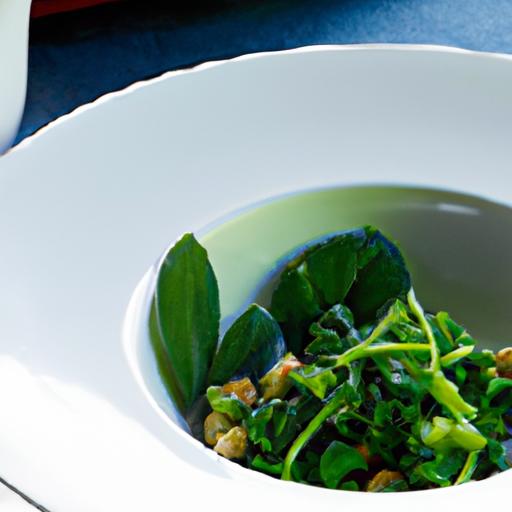Foragers know that the wild bounty of nature is as fleeting as the seasons themselves, and among its verdant treasures, nettles stand out as a paradoxical gem-delicious yet stinging, humble yet packed with nutrients. Drying nettles transforms these prickly weeds into a versatile pantry staple, unlocking their earthy flavors and preserving their vibrant green goodness long after the spring flush has passed. In this guide, we’ll embark on a journey through the art and science of drying nettles, helping you capture the essence of wild greens so you can savor their healthful benefits year-round. Whether you’re a seasoned forager or a curious newcomer, learning to dry nettles is an essential skill that turns nature’s sting into a sustainable, flavorful delight.
Choosing the Perfect Nettles for Harvesting and Drying
Drying nettles begins with finding the freshest, most vibrant leaves. Early spring brings tender shoots, perfect for harvesting-choose young, bright green tops about 4-6 inches long. Avoid nettles with yellowing or damaged leaves, which can compromise flavor and nutrient content. Gloves are a must to safely pick without stings, and harvesting on a dry, sunny day ensures the leaves are free from excess moisture, making the drying process smoother and preserving nutrients.
Effective Techniques to Safely Dry Nettles Without Losing Nutrients
Preserving nettles while retaining their bright color and nutrient-packed profile involves gentle drying. Air-drying is one of the best methods: tie small bundles of nettles with natural twine, and hang them upside down in a dark, well-ventilated area. This slow, cool drying keeps chlorophyll intact, unlocking a deeper flavor and a green vibrancy that dried nettles are known for.
Alternatively, use a food dehydrator set to a low temperature-around 95°F (35°C)-to avoid overheating which depletes vitamins. Drying time varies but generally spans 6-12 hours, until leaves crumble easily. Remember, drying nettles properly safeguards their health benefits, including iron and vitamins A and C, ensuring culinary magic long after harvest.
Storing Dried Nettles to Maximize Freshness and Flavor
Once dried, store nettles in airtight glass jars, ideally in a cool, dark cupboard. Avoid plastic bags as they can cause dampness and stale flavors. Adding a small food-safe desiccant pack helps absorb residual moisture, extending shelf life to up to a year. Label containers with the harvest date to enjoy your nettles when they’re at their peak flavor. For an extra sensory delight, gently crush a few dried leaves before sealing to awaken their aroma.
Creative Ways to Use Your Preserved Nettles in Everyday Cooking
Rehydrated or ground, dried nettles add a subtle, earthy depth to many dishes. Brew them as a nourishing tea by steeping a tablespoon of dried nettles in hot water for 5-7 minutes. Incorporate powdered nettles into homemade pasta dough or sprinkle over roasted vegetables for a vibrant pop of green color and nutrients.
Blend rehydrated nettles into creamy soups or pestos paired with garlic, lemon, and toasted pine nuts to craft fresh, garden-inspired flavors all year round. Toss dried nettles into bread or savory muffins for a humble yet powerful green boost that delights both palate and body.
Prep and Cook Time
- Preparation: 10 minutes
- Drying Time: 6 to 12 hours (depending on method)
Yield
- About 1 cup dried nettle leaves from 4 cups fresh
Difficulty Level
- Easy
Ingredients
- 4 cups fresh nettle tops (young leaves and stems, about 4-6 inches long)
- Natural twine or string for bundling
- Glass jars with airtight lids for storage
- Optional: food-grade desiccant packs
Instructions
- Wear gloves and carefully snip young nettle tops with clean scissors or garden shears during dry weather.
- Gently rinse the nettles under cold water to remove dirt or insects; shake off excess water.
- Pat dry with a clean towel and lay the nettles on a paper towel-lined surface for 10-15 minutes to air dry further before bundling.
- Gather small bunches (3-4 nettle stems) and tie tightly with twine.
- Hang bundles upside down in a dark, airy room away from direct sunlight for 6-12 days until completely dry and brittle to the touch.
- Alternatively, arrange nettle leaves on dehydrator trays set to 95°F (35°C). Dry for 6-12 hours, checking every 2 hours to prevent overdrying.
- Once dry, crumble nettle leaves gently between your fingers to break them into smaller pieces if desired.
- Transfer dried nettles to clean glass jars, optionally placing a desiccant pack inside to keep moisture out.
- Seal jars tightly and store in a cool, dark place for up to one year. Label with date of harvest.
Chef’s Notes
- Use young nettle shoots in spring for a milder flavor; mature leaves can be tough and bitter.
- Fully dried nettles will snap easily; if not, continue drying to prevent mold growth.
- Store nettles away from heat sources to protect delicate nutrients.
- Rehydrate dried nettles by soaking in warm water for 10 minutes before cooking.
- Substitute nettles with sorrel or spinach when fresh nettles are unavailable.
Serving Suggestions
- Brew dried nettle tea garnished with fresh mint and a drizzle of honey for a refreshing, healthful drink.
- Add crushed dried nettles to savory breads or crackers for a nutritional twist.
- Fold rehydrated nettles into scrambled eggs or frittatas with fresh herbs and goat cheese.
- Whisk powdered nettles into your favorite pesto recipe with basil, pine nuts, garlic, and parmesan for a vibrant green spread.
| Nutrient | Quantity (per 1 tbsp dried nettles) |
|---|---|
| Calories | 7 kcal |
| Protein | 1.1 g |
| Carbohydrates | 1.3 g |
| Fat | 0.1 g |
For more inspiration on preserving wild greens, check out our complete guide to wild edible foraging and preservation. To learn more about the nutritional benefits of nettles, visit the Nutritional Data on Nettles.

Q&A
Q&A: Drying Nettles – A Forager’s Guide to Preserving Greens
Q1: Why should a forager bother drying nettles instead of eating them fresh?
A1: Fresh nettles are undeniably delicious and packed with nutrients, but they’re also perishable and can be a bit prickly to handle. Drying nettles not only tames their sting permanently but also extends their shelf life dramatically. This means you can enjoy the verdant goodness of nettles long after the growing season has ended-a true treasure in the winter pantry!
Q2: When’s the best time to harvest nettles for drying?
A2: Early spring is your golden window! Young, tender nettle shoots-usually 6 to 12 inches tall-are at their most flavorful and nutrient-rich. Harvest them before they flower to ensure the best taste and texture. Plus, picking nettles early in the day when the dew has dried off can help reduce moisture during drying.
Q3: How do you safely harvest nettles without getting stung?
A3: Think of nettles like a spiky handshake with nature-you need the right gloves! Wear sturdy gloves and long sleeves to protect your skin from those tiny, blister-inducing hairs. Use scissors or garden shears to snip off the tops of the nettle plant. Handle carefully, and remember: the sting disappears once the leaves are dried or cooked.
Q4: What’s the best method to dry nettles?
A4: Air drying reigns supreme in simplicity and flavor preservation. Tie small bundles of nettle stems together and hang them upside down in a warm, dry, well-ventilated area away from direct sunlight. Alternatively, for a speedier approach, use a dehydrator set to a low temperature (95-115°F or 35-46°C). Avoid high heat to protect delicate nutrients and flavor.
Q5: How can you tell when nettles are fully dried?
A5: Properly dried nettles feel brittle and crumble easily between your fingers. There should be no hint of moisture or softness, which could invite mold. When fully dried, nettles transform from vibrant green to a darker, olive hue but retain their characteristic aroma.
Q6: How should dried nettles be stored for maximum longevity?
A6: Store dried nettles in an airtight container, like a glass jar or a resealable bag, kept in a cool, dark place. Removing as much air as possible helps maintain their potency and flavor. When stored properly, dried nettles can last for up to a year, ready to invigorate teas, soups, or pesto anytime.
Q7: What are some creative ways to use dried nettles in the kitchen?
A7: Oh, the possibilities! Crushed dried nettles make a vibrant tea with a mild, earthy flavor and a wealth of health benefits. Sprinkle nettle powder into smoothies, soups, or stews for a boost of green goodness. Plus, you can infuse oil or vinegar with dried nettles to add herbal depth to dressings and sauces. For the adventurous, blend them into homemade pesto or even incorporate them into baked goods for a nutritional punch.
Embrace the humble nettle and its natural sting turned gift-a wild green preserved through the art of drying, ready to nourish your palate and spirit all year round!
Insights and Conclusions
As the last leaves crisp and curl in your drying rack, you hold more than just preserved nettles-you hold a vibrant connection to the wild, a taste of spring captured for the months ahead. Drying nettles is more than a preservation method; it’s an invitation to honor nature’s cycles and savor the subtle, earthy flavors that fresh greens gift us. So next time you find yourself among the tall, whispering nettle patches, remember: with a little patience and care, you can carry the meadow’s green heart well beyond its fleeting season. Happy foraging, and may your pantry always be rich with the wild’s enduring bounty.


